
Use our lease addendum to make changes to a residential lease agreement already in effect.

Updated June 17, 2024
Written by Ioana Gagiuc | Reviewed by Susan Chai, Esq.
A lease agreement addendum is used to introduce additional provisions, terms, or conditions to an existing agreement without modifying the original content. It is a separate legal document that, once signed, becomes an integral part of the initial lease. Addendums typically establish pet policies, clarify maintenance obligations, or include stipulations regarding security deposits, among other purposes.
Use Lease Agreement and Month-to-Month Lease Agreement templates to create your original rental contracts.
A lease addendum is a supplementary document attached to an existing lease. While the agreement should contain all the terms and conditions of the rental arrangement, the addendum should address specific issues not covered initially. Its purpose is to introduce minor changes, clarifications, or regulations.
The rest of the terms in the original lease contract remain in effect, and only the terms included in the addendum differ. The same parties that signed the agreement should also sign the addendum for it to become a legally binding document.
Use the general lease addendum form to make changes that do not pertain to the specific circumstances below:
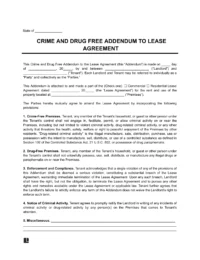
Establishes the illegal activity and drug policies of a rental property.
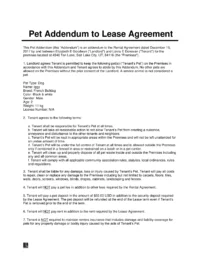
Lets a tenant know the specific rules for having a pet on your property.
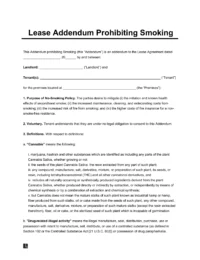
Prohibits tenants from smoking on the premises.
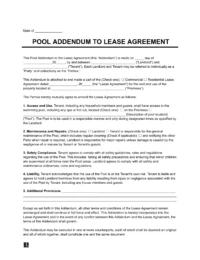
Use it to outline the terms related to the use, care, and maintenance of the swimming pool or hot tub.

Defines the types of alterations the tenant is allowed to make to the leased property.

Used by military personnel to terminate their lease early without penalty if they receive relocation orders or are called to active duty.

Use it to modify a fixed-term lease into a month-to-month tenancy.
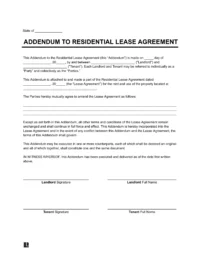
Expands upon an existing lease with extra rules or disclosures.

Use our Lease Extension addendum to extend your lease beyond its original date.

Changes specific terms agreed upon by the parties.
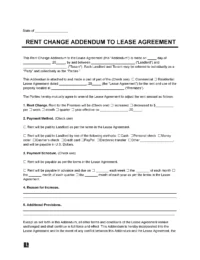
Details an increase or decrease in the rent amount.
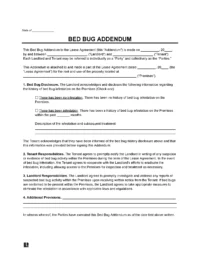
Provides information related to bed bug infestations on the leased premises.

Use to outline tenant responsibilities for preventing mold growth and requiring prompt reporting of any sightings to the landlord.
You can use addendums for residential lease agreements in many different situations. Some of the more common types of uses include:
Follow the steps below to write your rental agreement addendum:
Ensure that your original lease neither explicitly prohibits addendums nor imposes any restrictions on their implementation. Begin by searching for any provisions related to amendments or addendums. Many leases include clauses specifying conditions under which addendums are permissible, the scope of topics they can address, authorized signatories, and formatting requirements.
For instance, your lease might contain language allowing addendums but stipulating that they must be signed by all parties involved. Alternatively, it might specify that certain changes, such as alterations to rent amounts or lease duration, require mutual agreement from both the landlord and tenant.
Understanding the provisions outlined in the original lease will help ensure that any addendum you propose complies with the established contractual framework and can be legally enforced.
Once you’ve identified the possibility of implementing an addendum, it’s imperative to engage in open dialogue with your tenant regarding the proposed additional terms. Schedule a meeting or conversation to discuss the specifics of the proposed changes.
Work together to reach a consensus on the terms of the addendum, taking into account both parties’ interests and concerns. Once an agreement has been reached, formalize the terms in writing by preparing a written addendum that clearly outlines the agreed-upon modifications.
A valid contract is established when certain conditions are met. Firstly, both parties involved must be legally competent, typically defined as being over 18 years old and mentally sound, without impairment such as intoxication or mental disability.
Moreover, the formation of a valid contract necessitates an offer, acceptance, and consideration. This means that both parties must mutually agree to either perform or refrain from certain actions, and there must be an exchange of something valuable. For example, if you’re adding a provision to extend the lease term, you’re offering the tenant this extension in exchange for an increase in monthly rent or a one-time payment, which constitutes consideration.
Ensuring these elements are present in the addendum reinforces its legal validity and underscores the obligations and rights of both parties involved.
The tenant should be given sufficient time to review the document thoroughly. If, after reading, the tenant agrees with its contents and has no questions, they should receive instructions on signing. Once signed, any breach of the addendum’s terms will constitute a breach of the lease agreement.
If you do not get the new terms in writing with a tenant’s signature, you are less likely to be able to enforce the document in court in case of a later dispute. You also risk miscommunication with your tenant. In some cases, states may require a formal written agreement in order to be binding. For instance, in Massachusetts, when the lease is for more than a year, a court will not recognize any changes to the lease that are not in writing.
If a tenant declines to sign a lease addendum, the original lease agreement remains in effect, adhering to its initial terms. For instance, if a tenant declines to sign an addendum related to parking regulations, they must adhere to the parking terms stipulated in the original contract.
Similar to a lease agreement, addendum rules are legally binding. Failure to comply with an addendum can constitute a breach. In such cases, a tenant may face eviction from the property for non-compliance. Conversely, if a landlord fails to uphold the terms of an addendum, the tenant may be entitled to terminate the lease without penalties or obligations.
Below, you can download a lease agreement addendum template in PDF or Word format.